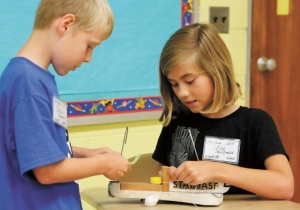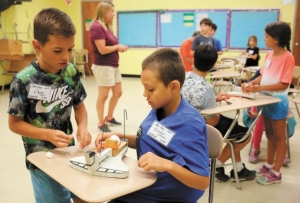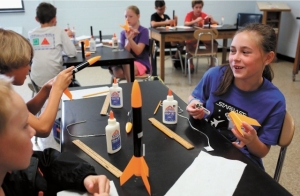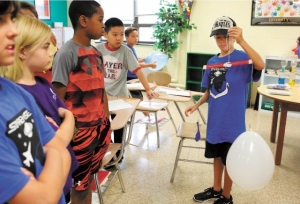Learning the science behind rockets
By Ethan Smith
Published in News on June 21, 2017 7:08 AM

News-Argus/CASEY MOZINGO
Corbin Richardson, 10, and Zoe McDonald, 10, construct a restraint devise during the STARBASE camp at Greenwood Middle starting with a bottle cap and string. Campers in each group were limited in their building materials and tested their construction later in the class.

News-Argus/CASEY MOZINGO
A group ties down their "Eggbert" to a wooden spaceship using a piece of yarn.

News-Argus/CASEY MOZINGO
Chase Sarro, 10, and Hunter Johnson, 9, discuss the design of the restraint devise made to hold a raw egg in place during a Laws of Motion experiment during STARBASE camp Tuesday at Greenwood Middle School.

News-Argus/CASEY MOZINGO
Emma Lewis, 10, laughs as she has difficulty assembling a rocket during STARBASE camp Tuesday at Greenwood Middle School.

News-Argus/CASEY MOZINGO
Jack Foery, 10, holds an unbalanced scale during an experiment meant to show the mass of air in the Oceans of Air class during STARBASE camp at Greenwood Middle School Tuesday.
Emblazoned on Eggbert's side is a simple statement: "I will survive."
Eggbert is a common, grocery-variety egg about to face a potentially life-ending event.
A group of three children, Katie Raabe, 10, Tyndall Steele, 10, and Carly Gerringer, 9, have strapped him into a wooden space shuttle replica.
Eggbert is secured by a pipe cleaner and clear tape, and is nestled into an upside-down bottle cap.
They've taped a penny to the contraption for good luck.
"We want him to land without cracking," Gerringer said.
This exercise is part of STARBASE camp, held at Greenwood Middle School, in which military and non-military children get to learn about science.
The trio was taking part in the "Laws of Motion" course, in which they had to secure an egg to a wooden space shuttle replica and send it down a zipline.
If Eggbert the egg was intact at the end of the journey, then they were successful.
As instructor Kristin Acorn sent the trio's Eggbert down the zipline, they waited at the end of the line in anticipation.
Thwack.
The contraption slammed into a metal pole.
Eggbert didn't even flinch -- or crack.
Other eggs were not so lucky.
The "Laws of Motion" was one of four courses the 42 children attending the STARBASE camp this week will participate in.
The other three courses were named "Oceans of Air," "Compass Reading" and "Rocket Building."
Each course was called a "flight" -- all four courses correspond to various things on Seymour Johnson Air Force Base.
Compass reading taught kids how to read a compass, and they built mock F-15E instrument panels -- compass included -- as part of the course.
At the end of the camp they will be required to use a compass to navigate to a specific spot on Greenwood Middle School's campus to show what they know.
Rocket building was precisely what it sounded like, in which students built small rockets that they will launch during the camp.
In "Ocean of Air," students not only learned that air has mass and takes up space, but also how it affects pilots on the base and the world around them.
This marks the 26th year the program has taken place, starting in 1992. Each element taught in the classroom pairs with an on-base component, during which participants tour various things on the base to learn how they work hands-on.
STARBASE Director Connie Atkinson developed the program in 1992 with the help of Francis Southerland and Norma Griffin.
It started as an all summer long course, but has been condensed into one week.
Several participants of the program have gone on to participate in the NASA program at N.C. State University, Atkinson said. She said the STARBASE program taught STEM (Science, Technology, Engineering and Math) before STEM education initiatives and curriculum were formally recognized.
Atkinson added that each "flight" during the camp stresses the importance of teamwork, teaching children how to work together to accomplish their goals.
"This helps them decide about the future," Atkinson said. "We are teaching the future here."
